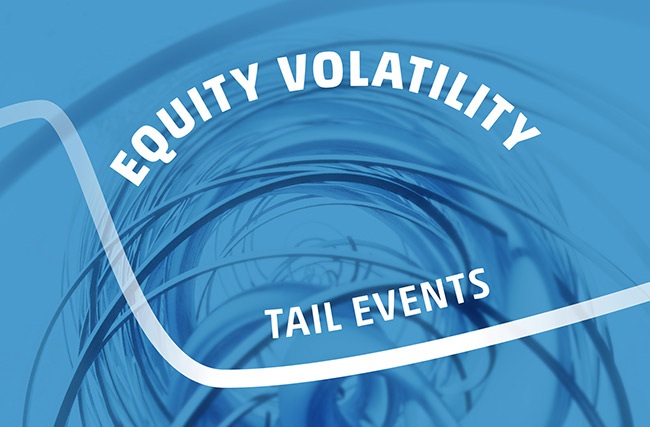Page 1: Volatility update January 2021

Review and Outlook
Happy new year! A common sentiment, both in the personal space as in the financial markets, has been the relief that ‘at least 2020 is over with’. But writing this article with the unprecedented events in Washington DC in the background, and grim new records still being set by Covid-19, one quickly realizes that a year is just a convention for classifying time and a new demarcation does not change the underlying situation. But it is nevertheless an opportunity to reflect, to take stock and look forward with fresh eyes. What can we learn from 2020? What should we expect in 2021?
Looking back at 2020, indeed it has been an extraordinary year in many respects. Before we turn to focus on financial markets, we should first acknowledge the human tragedy of the year. Covid-19 has claimed close to 2 million lives and there have been well over 90 million confirmed cases of the virus. As virus numbers continue to escalate in many parts of the world we are acutely aware that some readers will be going through this as we write. We extend our deepest sympathies to all those who have lost loved ones or who are suffering with the lingering effects of the virus and wish all our readers good health and happy times in the year ahead.
Turning to markets, it is natural that many of us will most readily recall the stressful times of 2020. However, looking at the calendar year as a whole, it is striking that the MSCI World1 had an unusually high +14% return, as the risk off move move in mid-Q1 – which saw a 33% drawdown – gave way to an even more aggressive resumption of the bull market from late March onwards.
2020 has again been a reminder that tail events may be infrequent, but they do occur, and can have big effects. However, timing them is the tricky part. The bull market years before 2008 were full of warnings about the rapid expansion in credit and risks in the housing market, while the excesses of the dotcom bubble were also widely commented on. And even the Covid-19 pandemic did not come fully out of leftfield. While the last truly global pandemic was outside of living memory for most, it was not an unknown risk. Indeed, in September 2019 the World Health Organisation published a major report, warning of the kind of tragic scenario which came to fore.2 There are always a plethora of risks to worry about and markets often seem to ignore them. But frequently enough to matter, some of these risks grow and become too big to ignore. Preparedness can yield big gains.
From a market perspective, tail events are never the same but they surely often rhyme, with common risk-off reactions including a flight to “safe”, liquid assets, a reduction in notional exposures (as the perceived risk exposure rises), an increase in the liquidity premium as well as risk premia in general, rising correlations and last but not least significantly higher volatility. Common risk models that focus on short-term measures of risk, or which allow low probability tails to remain unhedged (or even unacknowledged), often lead investors to have to make large adjustments in positions in short spaces of time just when markets are already moving in unusual ways. These were all seen again in Q1.
While things moved quickly, moves were not instantaneous – as in previous tail events, prices only really adjust significantly when people start (or cease) to transact, and market microstructure and positioning become important factors. Markets initially traded Covid-19 as a series of somewhat independent local events, but the interconnected nature of global supply chains and investors meant it then had a global impact that was more about capital market and supply linkages than the severity of cases in the domestic market. Time lags in reactions created trading opportunities.
Each crisis also tends to create new “never before” moments. Often these unprecedented moves are centered around over-reliance by some investors on structures that are short volatility and liquidity but manage to show good results for the last crisis. For those with dry powder, the inevitable unwinds can create trading opportunities, as they did in Q1. Sometimes, central bank support provides a lifeline, as it did in parts of the fixed income market in March. But sometimes it doesn’t, as for those who were short certain tail risks in equity variance. We are already seeing some market new niche products that worked in 2020 but embed similar short tails.
Moves in 2020 were faster than in 2008
The combined speed and magnitude of the moves in Q1 and Q2 was unusual, with the S&P 500 moving from high to low in 23 days (a 34% loss) and reaching a new all-time high by early September. The Nasdaq-100, which closed 2020 with one of its highest ever annual returns (+49%), was back at a new all-time high by early June. In the 2008 financial crisis, it took well over a year for the S&P 500 to go from peak to trough (Oct 2007 to March 2009), and it did not recover its losses until 2012. Both periods are a reminder that markets can change their perception of “risk” very quickly and do so in highly interconnected ways. In 2008/09 there were multiple periods of rapid losses, each creating stress and opportunities. In 2020 the stress and equity drawdown were concentrated in one period. As is typical in stressful periods, we found attractive trading opportunities and were pleased to deliver strong returns for our investors in Q1. Without the huge and rapid policy response, we believe markets would have looked more like 2008, which would likely have meant even more opportunities.

As in 2008, liquidity was a concern in some markets, though not in our areas of focus: our preferred habitat of short-term index options is one of the few places where liquidity tends to remain strong, and we saw this again in Q1, with our ability to transact unimpaired while the available opportunities increased. As we have discussed with many of our readers in the past, this is one reason we like our product set. At the same time, we also observed evaporating liquidity in longer-dated and more complex OTC option instruments where there are fewer natural buyers and sellers and buyside participants are often warehousing risks that banks either cannot or do not wish to hold. Outside of option markets, there were plenty of signs of liquidity constraints in credit and even major government bond markets until the huge central bank interventions.
Looking ahead
As we look ahead into 2021, what are the challenges and opportunities? While our strategy is quantitatively-driven and we are not macro traders, the overall environment is nevertheless an important backdrop. We would like to share our observations and the implications for volatility.
As others have argued elsewhere, we believe that one essential quest in 2021 will be the search for properly diversifying assets. For those tasked with macro asset allocation, both absolute value and diversification look harder to find in a world where central bank induced liquidity appears to be the tide that lifts all boats. Despite falling earnings in 2020, many equity markets are at new all-time highs. That makes the need for diversifiers appear stronger than ever.
Valuation arguments often seem to be based on something else being more expensive, namely, government bonds. High equity P/Es do seem more sustainable if long-term real interest rates remain negative. But on the flipside, if bonds yields rise, that would seem to undermine the case for abnormally high P/Es. The increased interlinkage between equity and bond valuations could lead to positive, rather than negative, correlations between equities and bonds in equity sell-offs. We are increasingly hearing in our investor conversations agreement with GMO’s eloquent argument that investors should rethink the role of government bonds in their portfolios3. We will return to this below.
Staying with equities, multiple expansion is of course just bringing forward future returns. Either equity returns will be low or there needs to be strong future earnings growth. If markets are correct in pricing real interest rates to remain negative for decades to come, it suggests economic growth will be disappointing long-term. That may make it difficult for EPS growth to drive future equity returns. Alternatively, if fiscal spending and reforms have the hoped-for effects in boosting economic growth, presumably the neutral rate of interest will once again become positive. That would mean central banks will no longer need to provide as much stimulus, and long-term projected future earnings should once again be discounted relative to those that are closer to hand. That could impact the growth trade and associated multiple expansion that has so boosted equity markets in recent years. The brief, but violent rotation on 9 November following the positive news on the Pfizer vaccine is an example of this dynamic. It is worth asking whether it is good or bad for P/E ratios if fiscal spending boosts growth and leads to higher rates? Uncertainty could drive interesting volatility around economic data surprises in 2021.
Continue reading to the next page of this article >>
–––––––––––––––––––––––––––––––
The full publication of this article is available as a PDF. Download it following the link below:
January 2021 Volatility Update >>
–––––––––––––––––––––––––––––––
1. Throughout this document, MSCI World refers to the MSCI World Total Return Hedged to US Dollars (source: Bloomberg).
2. “A World at Risk: annual report on global preparedness for health emergencies”, World Health Organisation Global Preparedness Monitoring Board, September 2019 apps.who.int. The report warns of the theoretical risks of “high-impact respiratory pathogens… spread by respiratory droplets… [and which can] move rapidly across multiple geographies”
3. See gmo.com
4. See microstrategy.com
5. Indeed, we note that one well respected asset manager has recently launched a product based on the prediction of a TMT unwind similar to that seen from 2000-02
6. “Distress looms over U.S. commercial real estate in 2021”, Marketwatch, 13 December 2020; marketwatch.com;
7. “Billionaires’ Row Condo Records 51% Resale Loss in Luxury Glut”, Bloomberg, January 8, 2021 bloomberg.com;
“Ho, ho — oh, no! Values of troubled Manhattan retail properties sink 53%”, Marketwatch, December 8, 2020; marketwatch.com
8. Avalos, Fernando and Xia, Dora, “US Treasuries and equity sell-offs: is the hedge faltering?”, BIS Quarterly Review, 7 December 2020
9. Indices used are the Bloomberg Barclays US Government Inflation-Linked All Maturities Total Return Index and the Bloomberg Barclays Global Inflation Linked Index Hedged USD and its unhedged equivalent. Source: Bloomberg
10. US Vol = VIX Index; Europe Vol = VStoxx Index; Japan Vol = Nikkei Stock Average
Volatility Index; Korea Vol = Kospi 200 Volatility Index (source: Bloomberg)
11. Sources: Bloomberg, True Partner. Data from Jan 2006 or earliest available through 12 Jan 2021.
12. “Are we on the verge of another financial crisis?” Harvard Business Review, 18 December 2020 hbr.org
- AI Top or Slop: When Markets Reach Peak Magnificence
- The Hedge Fund Journal features True Partner's award-winning volatility strategies
- True Partner Fund wins award for strong performance
- True Partner releases new thought piece focused on Dutch pension funds
- True Partner Fund nominated for best performing relative value fund
- Bloomberg article highlights True Partner’s strong performance in April and year-to-date
- Bloomberg Publication: True Partner Volatility Hedge Fund Gains 5.9% During April Rout
- True Partner to join the London Volatility Investing Event 2025
- Wat zijn de gevolgen voor pensioenfondsen van een zware beursdaling?
- What would a significant market downturn mean for Dutch pension funds?
- More news articles >
- Go to events >